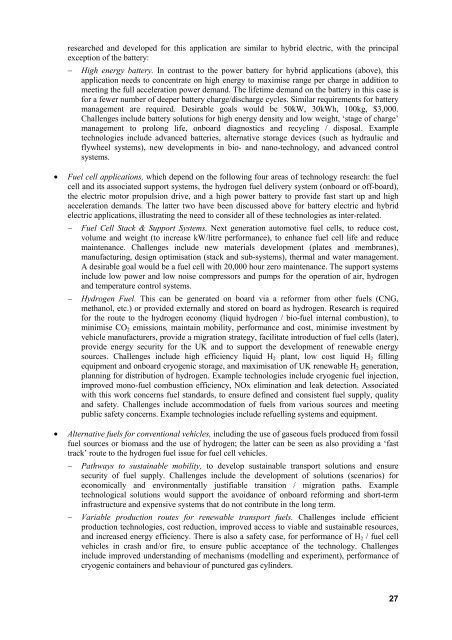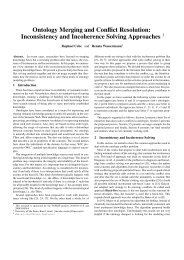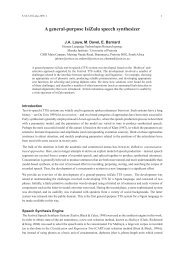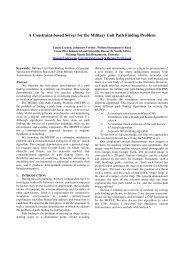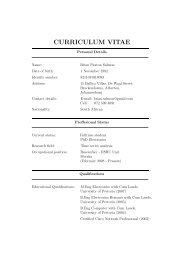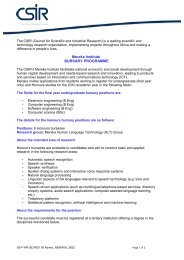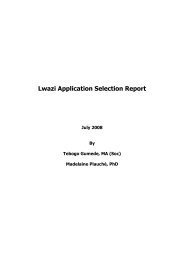Foresight Vehicle Technology Roadmap - Institute for Manufacturing
Foresight Vehicle Technology Roadmap - Institute for Manufacturing
Foresight Vehicle Technology Roadmap - Institute for Manufacturing
- No tags were found...
You also want an ePaper? Increase the reach of your titles
YUMPU automatically turns print PDFs into web optimized ePapers that Google loves.
esearched and developed <strong>for</strong> this application are similar to hybrid electric, with the principalexception of the battery:High energy battery. In contrast to the power battery <strong>for</strong> hybrid applications (above), thisapplication needs to concentrate on high energy to maximise range per charge in addition tomeeting the full acceleration power demand. The lifetime demand on the battery in this case is<strong>for</strong> a fewer number of deeper battery charge/discharge cycles. Similar requirements <strong>for</strong> batterymanagement are required. Desirable goals would be 50kW, 30kWh, 100kg, $3,000.Challenges include battery solutions <strong>for</strong> high energy density and low weight, ‘stage of charge’management to prolong life, onboard diagnostics and recycling / disposal. Exampletechnologies include advanced batteries, alternative storage devices (such as hydraulic andflywheel systems), new developments in bio- and nano-technology, and advanced controlsystems.Fuel cell applications, which depend on the following four areas of technology research: the fuelcell and its associated support systems, the hydrogen fuel delivery system (onboard or off-board),the electric motor propulsion drive, and a high power battery to provide fast start up and highacceleration demands. The latter two have been discussed above <strong>for</strong> battery electric and hybridelectric applications, illustrating the need to consider all of these technologies as inter-related.Fuel Cell Stack & Support Systems. Next generation automotive fuel cells, to reduce cost,volume and weight (to increase kW/litre per<strong>for</strong>mance), to enhance fuel cell life and reducemaintenance. Challenges include new materials development (plates and membranes),manufacturing, design optimisation (stack and sub-systems), thermal and water management.A desirable goal would be a fuel cell with 20,000 hour zero maintenance. The support systemsinclude low power and low noise compressors and pumps <strong>for</strong> the operation of air, hydrogenand temperature control systems.Hydrogen Fuel. This can be generated on board via a re<strong>for</strong>mer from other fuels (CNG,methanol, etc.) or provided externally and stored on board as hydrogen. Research is required<strong>for</strong> the route to the hydrogen economy (liquid hydrogen / bio-fuel internal combustion), tominimise CO 2 emissions, maintain mobility, per<strong>for</strong>mance and cost, minimise investment byvehicle manufacturers, provide a migration strategy, facilitate introduction of fuel cells (later),provide energy security <strong>for</strong> the UK and to support the development of renewable energysources. Challenges include high efficiency liquid H 2 plant, low cost liquid H 2 fillingequipment and onboard cryogenic storage, and maximisation of UK renewable H 2 generation,planning <strong>for</strong> distribution of hydrogen. Example technologies include cryogenic fuel injection,improved mono-fuel combustion efficiency, NOx elimination and leak detection. Associatedwith this work concerns fuel standards, to ensure defined and consistent fuel supply, qualityand safety. Challenges include accommodation of fuels from various sources and meetingpublic safety concerns. Example technologies include refuelling systems and equipment.Alternative fuels <strong>for</strong> conventional vehicles, including the use of gaseous fuels produced from fossilfuel sources or biomass and the use of hydrogen; the latter can be seen as also providing a ‘fasttrack’ route to the hydrogen fuel issue <strong>for</strong> fuel cell vehicles.Pathways to sustainable mobility, to develop sustainable transport solutions and ensuresecurity of fuel supply. Challenges include the development of solutions (scenarios) <strong>for</strong>economically and environmentally justifiable transition / migration paths. Exampletechnological solutions would support the avoidance of onboard re<strong>for</strong>ming and short-terminfrastructure and expensive systems that do not contribute in the long term.Variable production routes <strong>for</strong> renewable transport fuels. Challenges include efficientproduction technologies, cost reduction, improved access to viable and sustainable resources,and increased energy efficiency. There is also a safety case, <strong>for</strong> per<strong>for</strong>mance of H 2 / fuel cellvehicles in crash and/or fire, to ensure public acceptance of the technology. Challengesinclude improved understanding of mechanisms (modelling and experiment), per<strong>for</strong>mance ofcryogenic containers and behaviour of punctured gas cylinders.27


